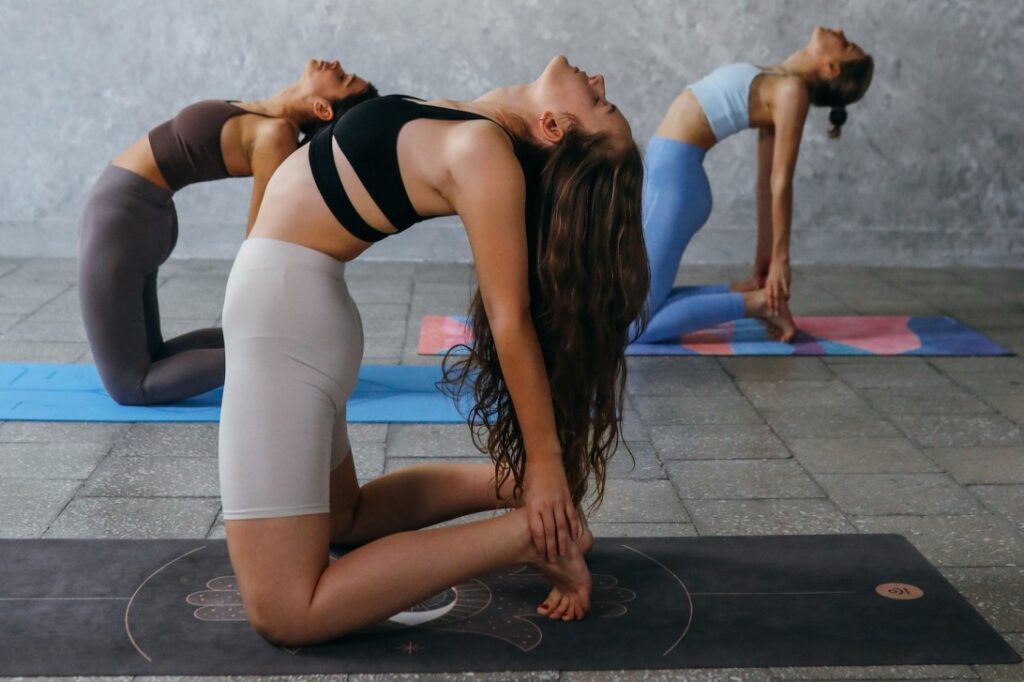Camel Pose, also known as Ustrasana in Sanskrit, is a deep backbend pose in yoga. It is named after the camel-like arch that the body forms in the pose.

How to do Camel Pose?
1. Start on your knees with your hips over your knees and your feet flat on the floor.
- Make sure your knees are hip-width apart and your toes are pointing forward.
- Sit up tall and engage your core muscles.
2. Place your hands on your lower back, with your fingers pointing down.
- Your hands should be placed on either side of your spine, just above your hips.
- Spread your fingers wide and press your palms firmly into your back.
3. Inhale and arch your back, lifting your chest towards the sky.
- Keep your shoulders down and your chin lifted.
- Gaze towards the ceiling.
4. If possible, reach back and place your hands on your heels.
- If you can’t reach your heels, place your hands on blocks or on your lower back for support.
- Keep your core engaged and your back arched.
5. Hold the pose for 5-10 breaths, or as long as you feel comfortable.
- Breathe deeply and evenly.
- If you start to feel any pain, come out of the pose immediately.
6. To release the pose, exhale and slowly lower your back down to the starting position.
Benefits of Camel Pose
- Opens up the chest and shoulders
- Stretches the spine and hip flexors
- Strengthens the back and legs
- Improves balance and flexibility
- Stimulates the thyroid gland
- Relieves stress and anxiety
- Help to unblock the heart chakra
Tips for Beginners
If you are new, start by modifying the pose. You can place blocks under your hands or knees for support, or you can try a variation of the pose, such as Supported Camel Pose.
Start by holding the pose for a shorter amount of time, and gradually increase the duration as you become more comfortable.
Listen to your body and don’t push yourself too hard.
If you feel any pain, come out of the pose immediately.
Variations of Camel Pose
Supported Camel Pose: Place your hands on a chair or wall behind you for support.
Reclining Camel Pose: Lie on your stomach with your arms overhead. Bend your knees and bring your heels towards your buttocks. Reach back and grab your heels with your hands. Gently arch your back and lift your chest off the floor.
Kneeling Camel Pose: Stay on your knees but keep your back arched and your chest lifted. You can also reach back and grab your heels for support.
Safety precautions
Avoid Camel Pose if you have any back injuries, such as a herniated disc.
If you are pregnant, avoid reaching back to grab your heels. Instead, place your hands on your lower back for support.
Conclusion
Ustrasana is a great way to open up your chest and shoulders, stretch your spine and hip flexors, and strengthen your back and legs. It is also a good pose for improving your balance and flexibility. If you are a beginner, start by modifying the pose and gradually increase the difficulty as you become more comfortable.
Personal Note
Camel Pose can be a challenging pose, but it is also a very rewarding one. It is a great way to open up your body and mind, and it can leave you feeling energized and refreshed. If you are new to yoga, I recommend starting with a beginner class where you can learn the pose safely and correctly. With practice, you will be able to master Camel Pose and enjoy all of its benefits.




